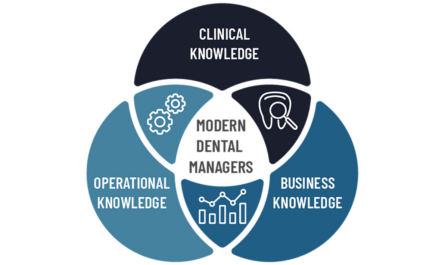By tracking your financial performance, you can make the informed decisions needed to grow your organization.
By Ken Kaufman, President/CFO, Nuvia Dental Implant Center
Finances are a major pain point for any business, any industry. No matter what line of work you are in, generating and perpetuating revenue is one of the bigger obstacles you have to overcome every month. Without the right financial systems in place to track your financial performance, you will not be able to make the informed decisions that you need to grow your organization.
Establishing financial systems within your dental practice is a critical component to the success of your practice. When you have good, solid financial information, it empowers you to look backward to see what has been successful, as well as look forward – equipping you to plan your next steps. These systems can remove any anxiety you might feel about your business and replace it with confidence that is overwhelmingly powerful.
Here are seven key financial systems you can use to build your dental practice:
1. Monthly financial statements
Monthly financial statements are a truth-teller. If you are looking at making a big investment, your monthly financial statements will show you through the numbers whether that’s a wise decision or not. The monthly financial statement should include an income statement, a balance sheet and a statement of cash flow. It can be easy to laser-focus on just one of these documents, but every good business operator understands that you need all three for the full picture.
The faster your accountant or accounting team can get you these financial statements, the better off your organization will be. Early documentation allows you as an operator to see what’s happening and to quickly make relevant changes or decisions that will help your business. You should expect your monthly financial statement no later than the middle of the following month, and hopefully sooner!
2. 90-day cash forecast
I believe that you cannot truly claim the title of entrepreneur unless you have been less than a week away from payroll and not had enough cash in the bank to make payroll. That is, I think, the true evidence that you have reached one of the pinnacles of entrepreneurship. Cash management is so critical.
When you have 90 days to solve a cash flow problem, it’s much easier to solve that problem long before it becomes a serious concern. If you have three days to solve a problem, but you don’t have enough cash for payroll, that’s a much harder problem to solve. This is why we call the 90-day cash forecast the “sleep well at night report.”
This forecast needs to be updated weekly because your business will change that frequently. You need to look for whether you are burning or accumulating cash week over week, as well as what levers you have if you see shortages or declines within the next 90 days. It’s all about short-term forward-looking visibility.
3. Annual budget with monthly variance analysis
The annual budget with monthly variance analysis is a specific process that identifies the track that you are currently on and pinpoints what you need to do to get where you want to be. You should be asking hard-hitting questions like: How do we try to make improvements? Where do we want to push? Where do we want to stretch? Where do we want to try and add specialty services? Where do we want to try to change some behaviors and create better outcomes for our patients?
After you have answered those questions, set a goal for your organization and your team for the year. Once the goal and the budget are set, you need to be prepared to evaluate your variances on a monthly basis. The process of evaluating those variances and invalidating/validating each of the assumptions you made is more instructive and makes you a more powerful operator than creating the budget in the first place.
4. 12-month rolling forecast
The 12-month rolling forecast is your vision to the future, a sort of crystal ball that helps to guide your decisions and shape your vision. This is something that you should always have written down on paper, or in an Excel spreadsheet with plenty of rows and columns. This forecast can help you stay on track with what you’re currently doing, while showing you what 12 months in the future could look like.
Building forecasts are essential to streamline your vision, not just in the way you strategize the future of your business but in how you make the decisions that will affect you in the long-term. By mapping out a 12-month plan and keeping this forecast updated for the next 12 months, you are investing into the future of your team and your company.
5. 5-year financial model including cap table
This model is so important because it takes your current business and marries it up with your ideas and future strategies, putting them through a financial rigor that creates a lens demonstrating how profitable your organization could be, as well as what the equity value should be. Every entrepreneur who has grown a business will agree that the most valuable financial tool to maximize impact and enterprise value long term is the five-year financial model. It casts everything you are or will do in the business and lets you toggle between options so you know what changes in your business will be most meaningful and impactful for the stakeholders.
A capitalization table – or cap table – is a model that allows you to calculate the percentage of ownership and see the financial outcomes. For each owner. If you’re the full, 100% owner of your DSO, that means your cap table is you at 100%. If you have other partners, it will show what percentage of the equity each of those partners owns.
6. Proforma and investment thesis for all growth projects
If you are going to start a practice or launch a specialty office, a proforma is a forward-looking statement of what you think a specific project is going to do. Is the new specialty office going to keep referrals in-house? Will a new office in this region tap into an untouched market? Will this marketing initiative reach the intended audience? An investment thesis is all the logic that you are putting into the proforma to be able to look at what the financial outcomes are going to be.
7. Monthly and quarterly reporting package for all stakeholders
If you create one report that shows your financial performance and share it with every stakeholder in your business, it’s going to be too generic. Different stakeholders are looking for different information based on what part of the business they are the most active in. Having a generic report that tries to answer every question for every person in the business will end up answering no questions and will not be helpful at all.
The more you can tailor the information to the needs of each party.







